In an effort to bring you some new voices on Ottsworld, here is a guest post from Kit Parks. I met Kit at a blog conference. I learned that she is a podcaster and an avid long-distance hiker; we immediately hit it off! We shared stories on different long-distance walks and bonded! I invited her to write a guest post about the West Highland Way walk she did, and I did a podcast for her on the Kumano Kodo hike! I hope you enjoy her story as she shares her expertise on the hike! All opinions and experiences expressed here are hers. –Sherry
I met a delightful man from Scotland named Jamie while on a hiking adventure in Nicaragua.
Jamie was celebrating his 40th birthday later that spring and invited his friends on a hiking trip to Fort William, Scotland. He also invited our entire Nicaraguan group, and I was the only one to say, “Yes!”. I mean, c’mon??? How often do you get the opportunity to hang out with a bunch of Scots, right? Plus I’d get to hike one of Jamie’s favorite mountains. A no-brainer for me. But I couldn’t justify flying to Scotland for a weekend, so I decided to find something fun to do and make an adventure out of it.
Kismet! I discovered that Scotland’s most popular and arguably most beautiful long-distance trail runs from just outside Jamie’s hometown of Glasgow all the way to Fort William. And if I opted to hike the six-mile Kelvin Way from Glasgow, I could literally walk from my Glasgow hotel room all the way to the birthday party a hundred miles away. How cool is that?
Table of Contents
What is the West Highland Way?
The West Highland Way is a long-distance footpath that runs 96 miles (154 km) from Milngavie, (ten miles outside of Glasgow), north to Fort William through the Scottish Highlands. Scotland itself covers the northern third of Great Britain and borders England to the southeast and then is surrounded by the Atlantic Ocean.
The terminus, Fort William, is home to the British Isle’s tallest mountain, Ben Nevis, which stands at 4411’ (1345 m). You will see Ben Nevis as you near Fort William, but you do not climb it on the Way.
Much of the early trail runs alongside stunning Loch Lomond, the UK’s largest freshwater lake.

You walk through some of Scotland’s most beautiful scenery including ancient forests and moors (land that is neither cultivated nor forested), through absolutely charming medieval villages, along drover paths (livestock transfer trails), historic military roads, and of course, up and across the scenic hills that made Scotland famous.
The History of the West Highland Way
One of Scotland’s Great Trails, a collection of long-distance “people-powered” trails in Scotland, the West Highland Way was officially opened in 1980. Geographer Fiona Rose is credited with surveying and outlining much of the path envisioned by Tom Hunter of Glasgow in 1974.
Like many trails in Europe, the West Highland Way uses existing footpaths that have been used by locals for centuries. Therefore, via historical markers strategically placed along the route, you will also learn about the Scottish clans and the Massacre of Glencoe, the Jacobite Uprising, important military operations and more.

Eons back when the world of supercontinents collided, the impact formed the Appalachian mountain range, parts of Western Europe, and even parts of Africa. These are all part of the ancient Central Pangean Mountains. The Scottish Highlands of the West Highland Way are part of that chain of mountains and in 2010, it joined the International Appalachian Trail (IAT). The IAT starts at the northern terminus of the Appalachian Trail in Katahdin, Maine, and continues on to Europe and now includes the West Highland Way.
When the West Highland Way was officially opened by Lord Mansfield in October of 1980 it became the first and remains the most popular of Scotland’s twenty-nine Great Trails.
Check out my hiking packing list: Essential hiking gear for any hike
Walk the West Highland Way
Walking the West Highland Way was my first complete long-distance trail and I learned a lot that can help you have a fun and enlightening walking holiday. Do one long distance hike and you will become addicted like me!
Most people walk the West Highland Way as an intimate way to see and learn about Scotland, meet its people, and revel in its beautiful landscape.

This is a trail that any fit person can do, particularly if you train. You can even bike portions if that’s your preference. You don’t even have to carry a full backpack unless you want to, making it an even more accessible experience.
To see if this long-distance walk is for you, check out the Frequently Asked Questions about the magnificent West Highland Way.
Be sure to check out my Active Travel Adventures (ATA) podcast where I talk about my hike of the West Highland Way here.
West Highland Way FAQ’s
Who Can Walk the West Highland Way?
YOU!!! If you are reasonably fit and properly prepared, YOU CAN DO THIS! I’ll go over the difficulty a little further down, but most of the trail is manageable for anyone who can walk most of the day. There are a few steep inclines and descents, but mostly the elevation changes are gradual and you will rarely be out of breath.
The hills – most to me don’t really qualify as mountains – are very low. Altitude is NOT an issue. Where in Colorado they count the “14-ers” – mountains over 14,000’ high (4267 m) – in Scotland they count their “Munros”, which are mountains that are at least 3000’ (914.4m). There are 227 Munros in Scotland (and as a side note, my birthday friend Jamie has climbed them all).
Learn how to train for adventure travel on my ATA podcast and website.
Is the Trail Crowded?
Like many trails, it depends on when you go. I went at the beginning of June and while on most days I saw people on the trail throughout the day, I wouldn’t say it was crowded.

However, around 120,000 people walk at least a portion of the trail each year, including 36,000 thru hikers like myself. Most of these folks do so in May for the wildflowers, or July and August, but I recommend that you walk during the shoulder early spring season and possibly September (see below “When to walk the WHW”).
Can You Walk the West Highland Way Solo?
Absolutely! I did and had zero issues. On the plus side, you are more likely to meet people when you travel solo, such as my new Brit friend Simon, whom I will introduce you to in a bit.
When you travel solo, people are more curious about you and more likely to approach you than they would if you were chatting and hiking with someone else. Most days I had a ‘new-to-me’ hiking buddy for at least part of the journey. I still keep up with some of them!
There was never any place where I felt uncomfortable or unsafe along the route. Each of the little towns is charming and hospitable.
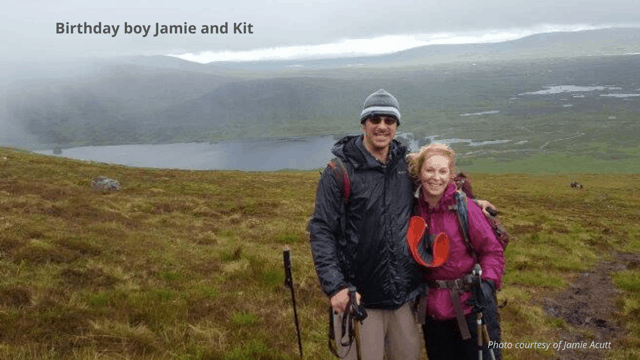
The downside of traveling solo in Scotland (like much of Europe) is that you will often have to pay the dreaded single supplement, which can add substantially to the cost of your lodging.
You can learn more about hiking solo on my Active Travel Adventures podcast and website.
How Difficult is the West Highland Way Hike?
I would say on a scale of 1 – 5, with five being super challenging, I would put it at a three. The three rating is not because of any really difficult sections, but because it is a challenge in and of itself to get up every morning for a week or so and hike most of the day, regardless of the weather or how tired your feet, knees and back are feeling.
Because of the spontaneity of my trip, I did not properly train my body to carry a pack, AND I decided to bring along a ton of electronic equipment to record my trip, so my pack was unnecessarily heavy.
I do not recommend going on this or any multi-day adventure like a long-distance hike without properly acclimating your body to the new daily stresses. If you train, you’ll have a much more enjoyable trip with less chance of injury.
I found hiking the multiple rocky steps along the path on the day I hiked to Inverarnan a bit challenging on my right knee because of the excess pack weight, so that night I added the drone, GoPro, and gimbal to my transfer luggage and decided my iPhone camera would work just fine!

I was a bit concerned about the intimidatingly named “Devil’s Staircase” that I had to climb en route to Kinlochleven, especially since there was a chance of ice that day. But while I had to take some time to catch my breath here and there, it was certainly manageable. Besides, the view from the top takes your breath away anyway:) When you reach the cairns that mark the summit at 1800’ (550 m) you’ve only climbed about a thousand foot (305 m) elevation.
Most of the time you are walking the WHW you are surrounded by the alluring peaks of the Highlands but not actually climbing over them.
What is the Best Time of Year to Walk the West Highland Way?
The official season for walking the West Highland Way is March through October, and the most popular time is May, July, and August. However, I would recommend late May to mid-June for two reasons: crowds and midges.
There aren’t a lot of places to stay along the route (see lodging below) and you want to enjoy your walk, right? You don’t want to be forced to walk a death march because there is no lodging available in the village where you would prefer to spend the night. And even if you book early enough to get your chosen lodging during the summer, the trail will be crowded.
How Bad Are the Midges?
But more importantly for your sanity and enjoyment, if you go in early spring you can avoid the bane called “midges”. These obnoxious, mini, almost invisible pests bite like the dickens. Plus they can swarm you and make your life miserable.
Midges love still, humid conditions. So you want to pray for a cold, dry spring. And while you are there, hope for windy, dry conditions as well. A hot dry early summer reduces the chance of a second generation. Great midge conditions such as a warm, wet summer, could mean yet a third fall generation which could affect even September hiking.
Baby boy midges emerge in late May, but they don’t bite. It’s the females (like mosquitoes) that want your flesh and they come out about a week later.
So, I recommend late spring, like when I went. You could go in early fall, but it can be pretty wet and you might still meet some midges.
I also recommend checking to make sure you avoid any festivals or other annual events before you book your walk.
What About the Weather?
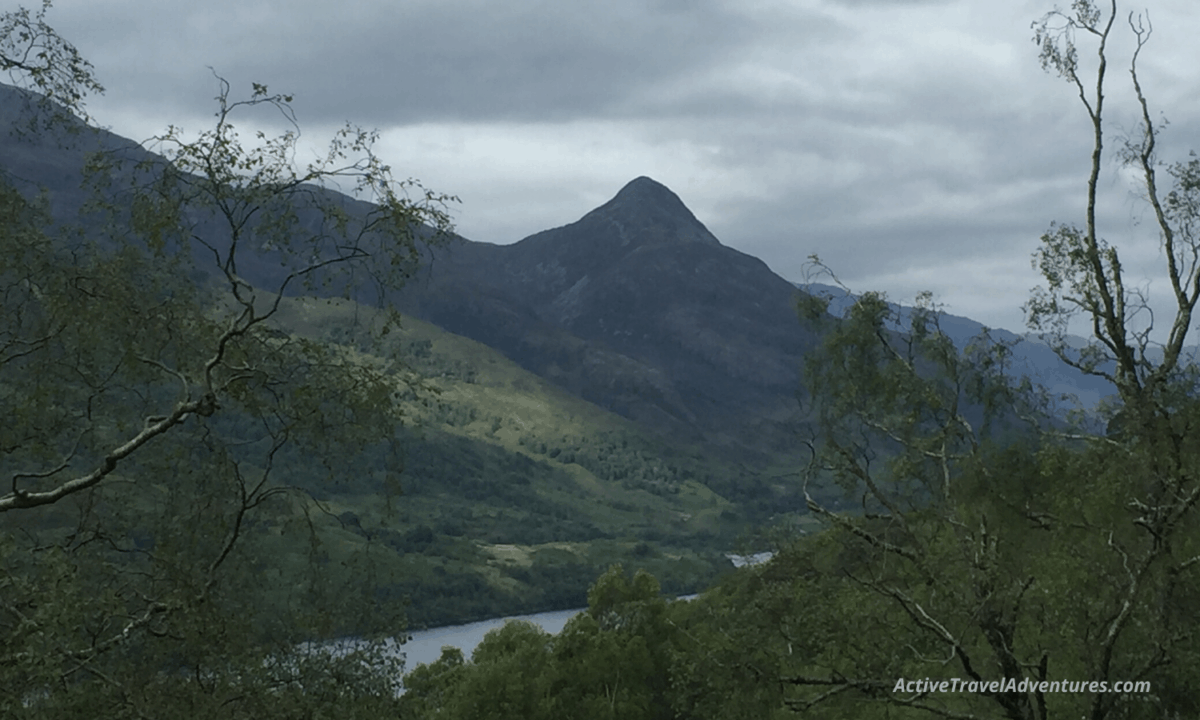
In Scotland, you need to be prepared for all four seasons, possibly even on the same day, any day of the year. Yes, that means that while the chances are less that you will see snow in summer, you still could.
On Jamie’s birthday hike in mid-June near Fort William, we were hiking a munro in whiteout conditions.
The day I hiked to Kingshouse was my only bad weather day along the WHW, but what a doozie! It was that sharp, stinging sideways rain with temps below forty degrees (F). My hands froze over my hiking poles even though I was wearing wool gloves (bring waterproof gloves – see the ”What to bring” section).
In fact, it was on this day that I wisely decided to catch the bus from Bridge of Orchy to Kingshouse rather than cross the most remote section of the trail, where there is NOTHING – not a road or building for fifty square miles – rather than risk something going wrong while I hiked alone in that brutal weather.
The reason that Scotland is so green and beautiful is because of all of the rain. You’ve got a 40-60% chance of rain every day of the year. May is the driest month, followed by March and June. But the fact that it is generally overcast means that you get to enjoy the brooding clouds that make for such dramatic scenery and fantastic photos!
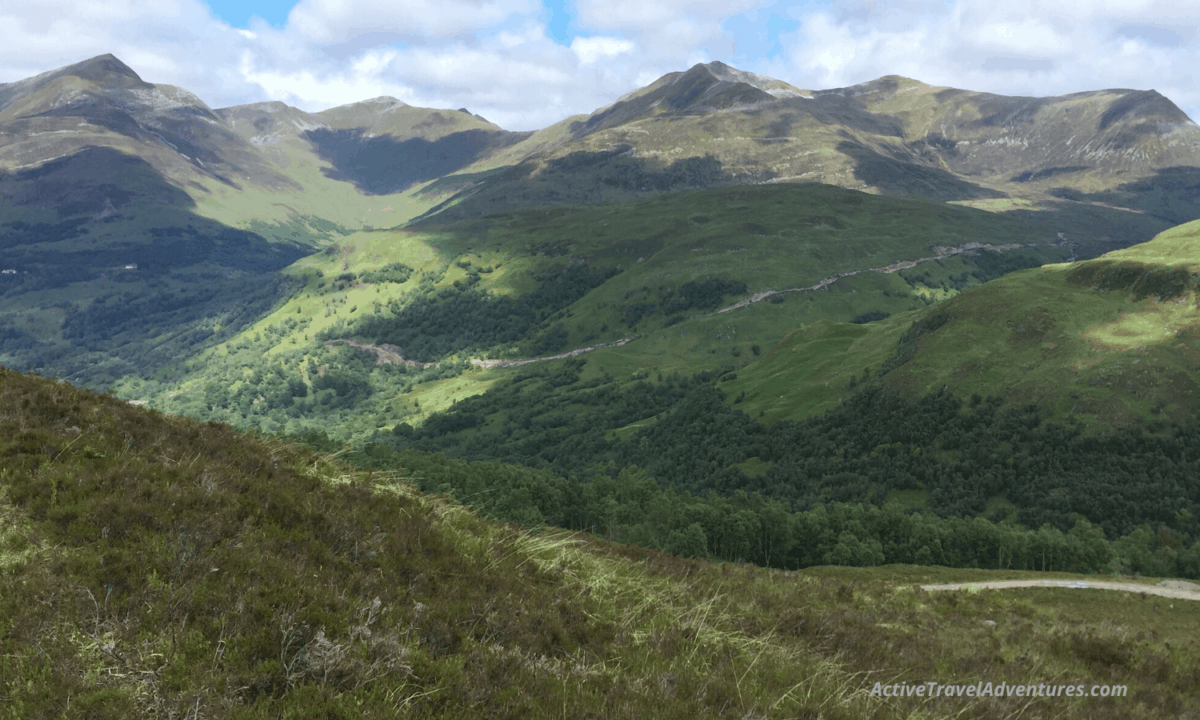
The weather is generally very cold in winter. Otherwise, most of the year it is either cold or cool. It is rarely warm or hot. This actually makes for great hiking weather because it is easier to add clothes than to remove them. Remember you are pretty far north: the sun in early June didn’t set until 11 pm and rose again around 2:30 am, so be sure to bring a sleeping mask.
Bring layers for all four seasons in your day pack every day even if the weather forecast is great – trust me here! Here’s a link to the average weather in Fort William, the endpoint of the WHW.
I was very lucky with my weather in that I only had one rainy day on my hike and a snow day for my birthday hike. But note that the weather down below the Munro for the birthday hike was sunny, warm, and gorgeous… it was once we climbed higher that we dealt with the snowstorm.
If you bring the right clothes, you will be fine.
Hike the Alta Via 1 in Italy’s Dolomites
West Highland Way Accommodations and Do You Need to Plan in Advance?
You have many options of TYPES of lodging but there isn’t much QUANTITY of lodging, so YES you need to plan your lodging in advance, especially if you go in the summer.
You can camp, stay in a bothie, a bunkhouse or hostel, a bed and breakfast, a guest house, or an inn that is part of a pub or restaurant.
Scotland allows wild camping at virtually any unenclosed land if you follow the guidelines. However, because of the traffic and worry of misuse, you are not allowed to wild camp along Loch Lomond. If you prefer to camp, there are a few campgrounds available.

A bothy offers more shelter than a tent. They have unlocked huts with sleeping platforms and a fireplace. These are free and you are expected to follow the Bothy Code of respect for both people and place. Of course, you’ll need your sleeping bag. There are two along Loch Lomond’s eastern shore.
Bunkhouses and hostels are an inexpensive alternative if you prefer a four-walled shelter. You’ll get a mattress but may need to rent linens. I would suggest bringing your sleeping bag and liner.
Bed and Breakfasts, Guest Houses, and Inns generally offer your morning meal, but sometimes not until 8 am, which is of no help if you want to get an earlier start. This is the type of lodging I chose and am grateful I spent the night in some charming guest houses, many of which were 500+ years old!
It is critical that you book your lodging in advance!
Most of the villages are quite small and after a long day’s hike, you want to make sure you have a place to rest your head. In the busy season, book six months to a year in advance. Regardless, book as soon as you can for the best selection.
My Hiking Experience at Villages Along the Way
Not only do you get to enjoy astounding landscapes as you walk the West Highland Way, you get to visit and walk through enchanting medieval villages! Here’s a rundown of the key waypoints starting from Milngavie as well as some of my experiences walking through them:
Milngavie
A suburb and commuter town 6 miles (10 km) from Glasgow and the start of the WHW. An obelisk denotes the starting point and you enter the path beneath an arch with the WHW name. The town’s name sounds nothing like it is spelled. You pronounce it “Mull-Guy”, an odd mashup from its Gaelic roots. Milngavie is in the Lowlands, so the trail starts gently enough, and you walk your way through a pleasant forest (dotted with wildflowers when I was there) and enter the Loch Lomond and the Trossachs National Park en route to Drymen.
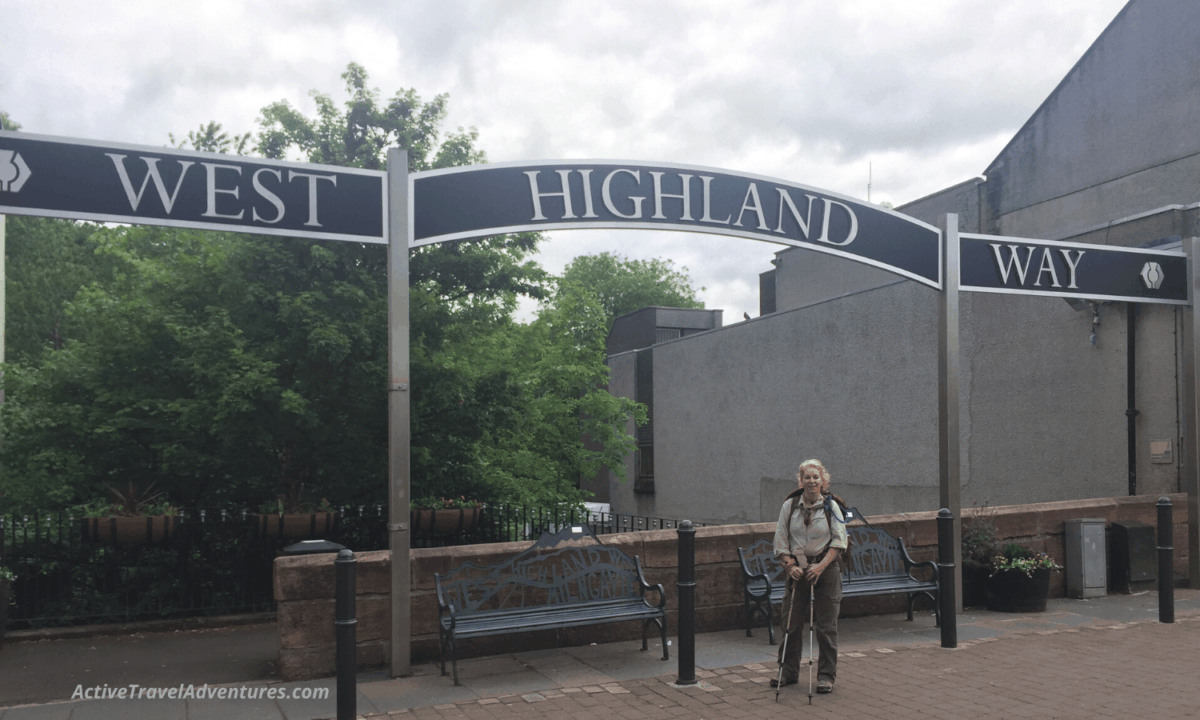
Drymen
And at the end of your day, stop for a cold one at reportedly the country’s oldest licensed pub, the Clachan, since 1734! Like most villages you’ll visit along the WHW, it’s small at less than 1000 population, but what it lacks in size, it offers in charm. And note that this is one of the largest towns you’ll visit along the WHW! This is also the last bank you’ll find until Tyndrum, so get your cash. Note that another long-distance trail, the Rob Roy begins in Drymen.

Balmaha or Rowardennan
From Dryman, you’ll walk towards lovely Balmaha and reach the beautiful ancient oak woodlands along the east bank of Loch Lomond (loch meaning ‘lake’). Unlike some long-distance trails, you don’t have to hike to the end to reach ‘pretty’… the WHW is gorgeous throughout and today you get a real taste of it. It was early in my hike, but because I’d heard how beautiful this section was, I chose a ‘rest day’ the next day to have more time to enjoy it. Pack a lunch and climb Conic Hill for one of the prettiest panoramic views of the hike! Also, you can take a ferry over to Inverbeg and Tarbeg if you want to explore more.

The downside of a rest day was that meant I was now a day behind my new friends, Linda and Russel, whom I met beside the fire at our inn in Drymen. I still keep up with Linda. One of the benefits of adventure travel: you meet cool, like-minded people from around the world!
Inverarnan
This was one of the prettiest days but also the most difficult day for me because of my right knee and my excess pack weight. You walk alongside the lake all day, but there are many rock steps that would ordinarily be fine, but with what I thought was a meniscus tear on my right knee, a tad painful for me on the downhills.
At least my slow pace allowed me ample time to enjoy the scenery! Luckily for me, when I made it to town, I was surprised by a visit from Jamie and his mom, Carol. We ate dinner at the, shall we say, unusual, Drymen’s Inn, built in 1705. I don’t recall the meal, but I do remember that there is a stuffed representative or two or three of all wild critters that have ever roamed Scotland on display. Whether you eat or stay here, it’s worth at least a drink to check it out.

I made sure to store my heavy electronics in my transfer luggage the next morning (see below for luggage transfer info) so that I could give my knee a break. Reminder: train!
Crianlarich
The next morning, my knee was feeling better and I got a quick start. Almost immediately another hiker caught up to me and started chatting as we walked along together. Let me introduce you to Simon from England. The beauty of adventure travel as I have mentioned, is the interesting and engaging people that you meet.
Within a few short hours, Simon and I had become fast friends and had lunch and a beer together in Crianlarich. Afterward, Simon continued hiking to Bridge of Orchy, another seven miles north, but we agreed to meet for dinner in Fort William a few days later. I spent a leisurely afternoon resting and exploring the small town. The next day was my longest mileage day and I wanted to get an early start.
Bridge of Orchy and the Kingshouse Hotel
I was scheduled for a 20-mile day (32 km) so set out at 5 am, meaning I left too early for my included 8 am breakfast. Fortunately, I had stocked up on some food at the little store the day before, so wasn’t too concerned.
What did concern me, however, was the appalling weather! It was that horrid rain I mentioned earlier.
It was an easy seven-mile hike to Bridge of Orchy and I went into the local Inn to warm up, dry off, get a hot meal, and think. I was really concerned about crossing the next 13 miles (21 km) of barren moor in this terrible weather.
This next section is the most isolated part of the WHW path, but it’s beautiful. If the weather is nice and you have the time for a detour, this Lairigmor area offers Scotland’s best ridge walk, the Mamore Ridge located just a bit up north.
While the trail is well marked, if I got lost in this awful weather, or anything went wrong or I got hurt, I might be in a serious situation. I decided to use my grey hairs and opt for safety, so I took the bus to Kingshouse. Smartest two bucks I ever spent.

The Kingshouse Hotel is the ONLY place to stay in the area, and it was closed for renovations. Fortunately, the company I hired to plan my self-guided hike (see below) knew this and arranged for a shuttle to pick me up from the nearby ski resort. While waiting for my afternoon pick-up, I enjoyed hot chocolate and soup while watching two crazy young kids mountain bike down the ski slope in all the rain and mud, and just have a blast.
My tour company transferred me to Glen Coe, which, if I ever go back to finish the section I skipped, I will make sure to spend a couple of days in this striking village about ten miles off the trail. The drive there was breathtaking!
Kinlochleven
I was a bit concerned about the weather for today because I had to climb the Devil’s Staircase. It turns out that it was hard but not killer, and the ice I feared turned to rain and then dried up altogether by the time I arrived. The view from the top is spectacular!!! It turns out that it was named after the devil by the workers who carved the rock that forms the steps that you climb up and down, NOT because it is such a killer ascent and descent. This section was an old military trail.
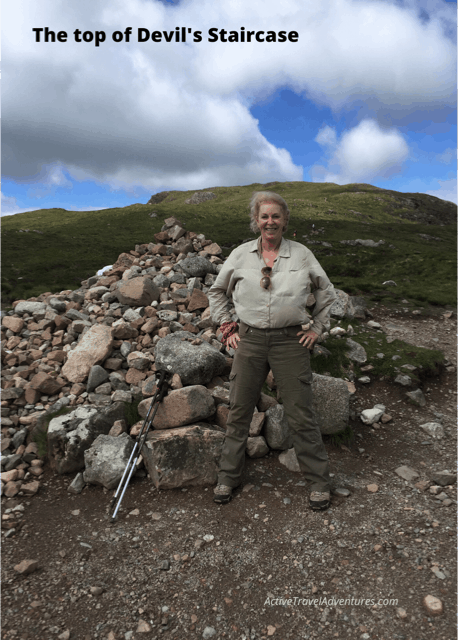
Remember Simon? When we reconnected a few days later, he told me he actually climbed the Staircase on that nasty rainy day and saw a crazy mountain biker biking down the steps towards Kingshouse!
As you near Kinlochleven, you’ll see some large odd silver tubes from the Aluminum Story which ferried water to power the aluminum smelter.
Once in town, might I suggest a whiskey at the Bothy Bar at the MacDonald Hotel? This teeny pub on the lake, Loch Leven, offers over 150 varieties of whiskey: try a flight!
And for pub grub, you’re liable to catch the local delicacy ‘haggis’ on special. You’ve earned it as you are almost to Fort William!
Fort William
The largest town in this part of Scotland and is considered the UK’s adventure capital, so if you can, allow a couple of days to explore. En route, you’ll pass the old fort and will finally see the UK’s tallest mountain, Ben Nevis.
You enter town and civilization again as Fort William is ten to twenty times larger than any you’ve seen all week.
As you walk down the main street among the shops and restaurants, be on the lookout for “Tired Feet” aka “Weary Walker” depending on who you ask. This is a slightly larger-than-life bronze statue of a triumphant walker who, like you, has finished the West Highland Way. This statute marks the end of your hike. Well done!!!

If your body and the weather cooperates, consider climbing Ben Nevis the next day (be sure to have a trail app and GPS on your phone in case the weather turns!).
Want something a little less intense? Catch the old-fashioned steam train to Mallaig, a fairy-tale train ride through the magical landscape of this old fishing village. Enjoy a bite, the museum, and a stroll through town before catching the train back to Fort William.
Simon was still in town when I arrived because he wanted to climb Ben Nevis and explore Fort William. So we had a celebratory dinner and posed with Tired Feet.
The next day, Simon set off to hike the Great Glen Way, another one of Scotland’s Great Trails. (For the record, Simon thought it was too easy and didn’t compare to the WHW). Later that day, Jamie and his mom came to greet me and take me back to Glasgow.
Happily, they took me the scenic route back along the Road to the Isles, considered Scotland’s Best Drive. If you have time, rent a car and do the same. Scotland is one of the prettiest countries I’ve ever been to.
Where Do You Eat Along the Way?
The villages are tiny and spread out so you should almost always buy something to take for snacks and lunch as you generally do not pass anything but sheep or a feral goat between villages. You can generally get breakfast and dinner in or near where you are lodging. Sometimes you will need to pre-book your dinner at your lodge before you arrive. Also, some hosts can make a packed lunch for you.
How Do You Find Your Way Along the WHW?

Gratefully the West Highland Way is very well marked. You will see signposts with the signature “Thistle” emblem at any intersection or decision point. Sometimes finding the turns in town might mean you look up on a street sign or other odd place, but look around and you’ll find them. It’s hard to get lost along the WHW, but still, bring a map and compass to be safe.
How Do I Get to the Start of the West Highland Way?
There are several easy ways to get to the trailhead from Glasgow. Of course, you could take a taxi, but consider WALKING from Glasgow like I did! The Kelvin Walkway starts in Glasgow and is a great warm-up for your long-distance hike. It’s only 6 miles (10 km) to Milngavie. You could also take a train or bus.
Should I Take an Extra Day in Glasgow Before My Walk?
If you can spare the time, I would say “Yes”! I was jet lagged with the five-hour time difference and remember being annoyed that the hotel was so noisy vacuuming in the middle of the night.
It turns out I had overslept and it was 10:30 am (5:30 am to my body). I was lucky that I didn’t miss my luggage transport that morning as my bag was supposed to be ready to go by 8:30 am.
So planning an extra day in Glasgow will give you time to enjoy this relatively affordable city and give your travel-weary body a rest before your big hike.
Do You Have to Walk the Whole West Highland Way at One Time?
Yes and No – it depends. If you want to skip a section, here’s the scoop:
There are certain sections that it is difficult to get to except by walking or taxi, for example, Balmaha to Rowardennan, or Rowardennan to Inversnaid. Inversnaid to Inverarnan means taking the ferry across the lake and a bus from there. Those darn lakeside mountains get in the way so you have to go around them via vehicle or else walk lakeside on the WHW trail.

The section from Kingshouse to Kinlochleven is also difficult to skip, but you could take a bus to Glencoe Village and from there to Kinlochleven.
However, these other sections have bus service (ask your hosts for current schedules) or you could take a taxi:
- Milngavie to Dryman
- Drymen to Balmaha
- Inverarnan to Crianlarich
- Crianlarich to Tyndrum
- Tyndrum to Bridge of Orchy
- Bridge of Orchy to Kingshouse (tell the driver you want to stop there)
- Kinlochleven to Fort William
If you are short days and need to skip a section, I’d recommend taking the bus to skip the section from Inverarnan to Tyndrum or even to Bridge of Orchy.
What if I Get Sick or Hurt?
There isn’t much in between villages so you’ll need to make it to the next town or send someone there for help. Like any time you go into the wilderness, carry an Emergency Kit. Don’t count on finding any pharmacies, so bring blister care, vitamin I (ibuprofen), or anything else you might need. Check out my Emergency Kit podcast and website for a checklist.
How Hard is it to Get Campfire Fuel?
You can get camp fuel at most general stores or campgrounds, however, Coleman fuel is not common.
What is the Etiquette For Crossing Pastures?
If the path crosses a pasture you may have to climb over the fence. Usually, there are makeshift steps for you, but if not, climb the gate on the hinge side. If the gate is closed, keep it closed and if the gate is open, keep it open. Do not approach or scare the livestock.
Can I Bring My Dog on The Hike?
Actually yes, but there may be detours during lambing season in mid-April to mid-May. You will see horrid photos posted on trees of lambs that were killed by dogs as a reminder, so be especially prudent around livestock. There may be restrictions as well during birding season. Keep your dog on a leash at all times and in your control.
What Types of Wildlife Will I See?
You are liable to see (or smell) a feral goat along the way. I saw one looking wistfully at a female in heat across the fence. You’ll also see a lot of birds, including golden eagles, ptarmigan and grouse. And naturally, you will see lots of sheep and the famous Highland cattle.
What Types of Flora Will I See?

Of course, you will see a lot of heather, but also the spear thistle, which is the flower used to denote your WHW path, some Caledonian pine specimens, rhododendron, sundew, and if you time it right, lots of other wildflowers along uncultivated areas.
For trees, you’ll find oaks, birch, aspen, ash, elm, and pine, so if the weather’s right, fall would make a nice show as you walk through the ancient forests.
How Hard is it to Understand the Scottish Brogue?
I didn’t have any trouble and found the sayings and accent delightful, but some might find it a bit harder to understand a deep Scottish accent. But it won’t be troublesome enough to cause anything other than a smile as you try to figure out what each other is saying.
Is There Baggage Transfer on the West Highland Way?
Yes! If you choose to backpack the trail, you can have your luggage transferred each day to your next lodging! If you hire a self-guided tour company, they will make arrangements for you. Otherwise, you can make them yourself with AMS or Sherpa Van. You usually have to have your bags ready by 9 am and then they will move them to your next stop by late afternoon. The charge includes one bag which they put a limit of weighing less than 44 lbs (20 kg). The luggage transfer service runs from late March to mid-October.
What Gear Do You Need to Walk the West Highland Way?

As I mentioned earlier, you need to be prepared for all four seasons any day of the year, including summer! So in your DAYPACK not your suitcase back at the hotel, make sure you have the following:
- Thermal jacket and wool gloves
- Rain jacket, rain pants, waterproof gloves
- Wide-brimmed hat in case you get lucky and get full sun; sunscreen and sunglasses
- Bug net for head for midge protection (I never needed it but it weighs nothing); mini bug repellent spray
- Emergency and First Aid Kit; flashlight or headlamp; whistle
- Map and compass
- Zip bag to collect your trash; toilet paper
- Water for the day; snacks and lunch
- Bandana
- If a really cold day is forecasted, bring or wear your base layer top and bottoms
Don’t Leave Without This Essential Hiking Gear
I’ve hiked all around the world and have found some key gear that I take on every hike for every kind of weather. From backpacks to socks, check out my list of the best hiking gear out there!
IMPORTANT NOTE: NEVER wear cotton. There is a saying, “Cotton Kills” and that is because it takes so long for cotton to dry when wet. If there is a slight chill and you get wet, you risk hypothermia. Wear instead the synthetic performance clothes and never jeans!
I prefer the long-sleeved hiking shirts that roll up to short sleeves and the zip-off hiking pants that convert to shorts. I also always wear “Smarwool” hiking socks with liner socks to prevent blisters and to keep my feet warm even when wet.
A trick to keep your gear dry: Line your pack with a compactor trash bag. They are super strong. Put everything in the bag and then twist the opening shut, fold the twisted edge over onto itself and either rubber band or large twist tie the top folded down. Viola! A perfectly dry daypack interior.
Do I Need Hiking Boots?
There’s no problem wearing hiking boots if you prefer ankle support, but it is not necessary. Hiking shoes are fine. While you probably could wear sneakers, I think the better traction of a proper hiking shoe is a better idea. Whatever you choose, be sure they are well-tested before you bring them so you can avoid blisters. Nonetheless, sneakers would be a better option than unbroken-in shoes.

How Much Does it Cost to Walk the West Highland Way?
There are no permits or fees to hike the West Highland Way. That means you can tailor your walking adventure to your budget.
You could go bare bones and backpack it, and then pick up groceries in the villages to cook. This wouldn’t cost you much more than it would at home except for transport to and from the trail and occasional campsite fees.
I would say that most accommodations are 2-3 stars along the trail, with some much nicer than the others. You don’t have much choice for inns and guest houses in the small villages so it pays to book early for the best pricing options and quality.
You will find walking holidays to be much more economical than traditional vacations because the main entertainment is your feet, and they are free.
How Long Does it Take to Walk the Entire Trail?
Most people choose to do it in eight days, but the range is 4-9. Simon, a super speedy hiker, backpacked it in four (although he wishes he’d known about the luggage transfer service). I chose to do it in nine because I wanted to sightsee along the way.
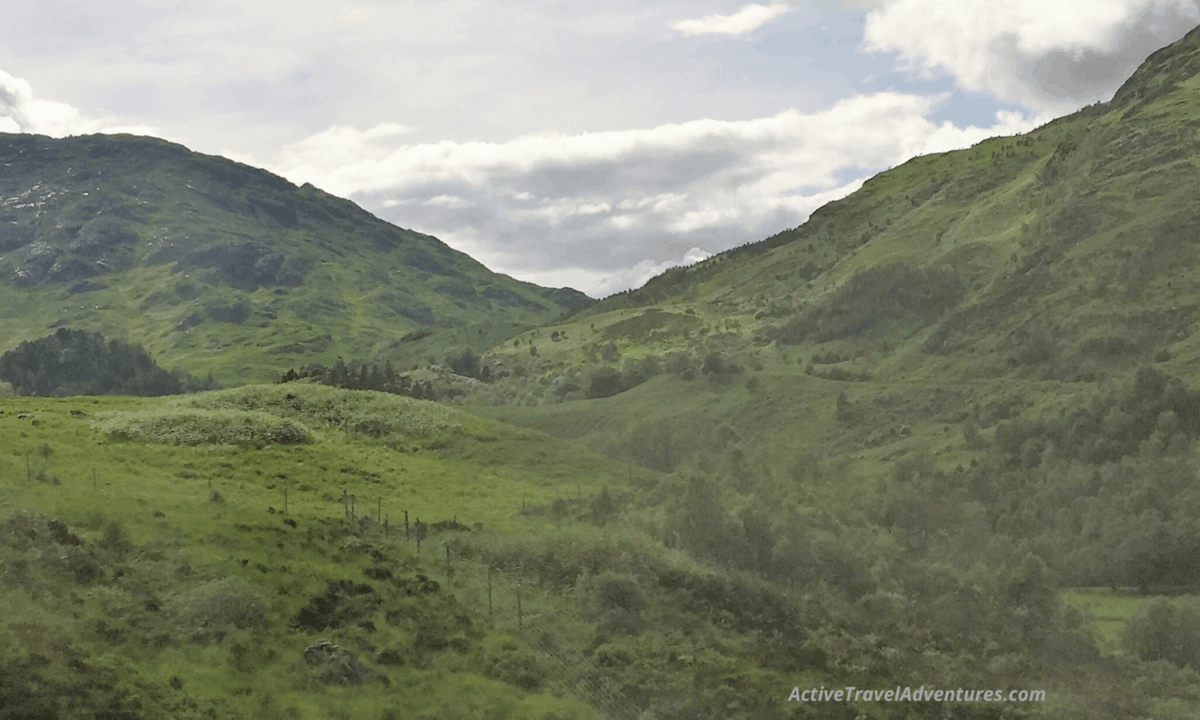
Basically, you can cater your trip to your budget and body, but keep in mind that if you want to sleep under a covered roof, the locations of the towns dictate a good part of your itinerary.
Approximate distances:
- Milngavie to Drymen 12 miles (19 km)
- Drymen to Balmaha 7 miles (11 km)
- Balmaha to Rowardennan 7 miles (11 km)
- Rowardennan to Inverarnan 7 miles (11 km)
- Inverarnan to Tyndrum 12 miles (19 km)
- Tyndrum to Kingshouse 20 miles (32 km)
- Kingshouse to Kinlochleven 9 miles (15 km)
- Kinlochleven to Fort William 16 miles (26 km)
Do I Walk Independently or With a Group?
Again, you have options here. You can plan and execute the entire adventure by yourself. I like the Sherpa Van website for doing this. These are the same folks who can move your luggage. They had a wonderful interactive site that helps you figure things out and even book your lodging for a fee.

I didn’t have the time to do research, so I chose to use a Self-guided Tour Company. I told them how many days I wanted to walk, that I wanted an extra night to explore the Balmaha and Rowardennan area and the date I wanted to start. They made all the arrangements from there for my lodging and luggage transfer, plus provided me with a waterproof map and guidebook. Then I walked solo following their itinerary.
I used the Footprint waterproof map and the Trailblazer guidebook.
Is There Internet Access?
I usually was able to get wifi when I was at my guest house. It may have been shaky, but I got a signal. You will be in a remote area so don’t count on any signal between villages.
Are there ATMs along the WHW?
Not many. It’s best to get cash in Drymen if you haven’t gotten it in Glasgow or Milngavie. Many merchants in the little towns prefer cash to a card. Note that the banks have an agreement with the Post Offices to allow withdrawals from a debit card.
Get Your FREE West Highland Way Travel Planner!
At Active Travel Adventures, we publish a FREE Travel Planning Guide for each destination and adventure. Want yours for the West Highland Way? Download it HERE.
Interested in Other Long Distance Walks?
Here are some of Sherry’s posts about other long-distance hikes:
Camino de Santiago – Spain
Camino de Ronda – Costa Brava Spain
Kumano Kodo pilgrimage – trails of Japan
St Olav Ways – Norway
Lycian Way – Turkey
Read about all of Sherry’s Best Hikes in the World
The Active Travel Adventures Podcast has featured many multi-day walking holidays. Here’s a sampling:
The Cotswold Way in England (where we will meet up with Simon again)
The Kungsleden Trail in Sweden
Mont Blanc circuit in Italy, France, and Switzerland
The Fisherman’s Walk Portugal
St Olav Ways in Norway with our own Sherry Ott
The UK’s Best Walking Holidays
PIN IT FOR LATER!


Meet the Author: Kit got bit by the adventure travel bug in her early 50’s and now makes it her mission through her Active Travel Adventures (ATA) podcast and website to inspire and empower you to lead a bigger life through adventure travel. On ATA, Kit chats with folks who have gone on exciting adventures like walking the West Highland Way, or even our own Sherry Ott about walking Saint Olav Ways in Norway or the Kumano Kodo in Japan. On each show, we are hiking, biking, and/or paddling as we explore new cultures and destinations. Check out the podcast directory here. If you are new to adventure travel and want to beef up your skills, check out Kit’s companion podcast, the Adventure Travel Show Podcast, which teaches you the skills you need to build the confidence to go on a grand adventure.
Connect with Kit:
Subscribe to either podcast for free from any podcast app or you can subscribe to the Active Travel Adventures podcast here and the Adventure Travel Show podcast here.
ATA Facebook | ATA Facebook Group | Twitter | Instagram | Pinterest
Disclosure:
This post contains some affiliate links. If you choose to purchase items through these links, I will earn a small commission at no extra cost to you. These commissions help reduce the costs of running this site

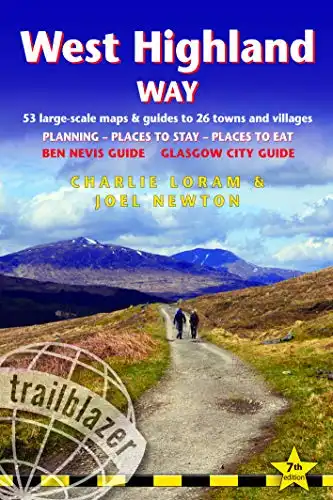

By John January 26, 2021 - 6:05 am
Hi
I think you meant to say “Drovers Inn”. You called it Dryman inn.
Cheers
John